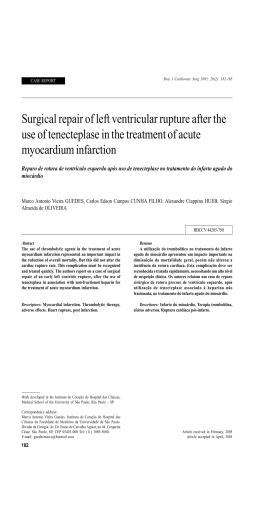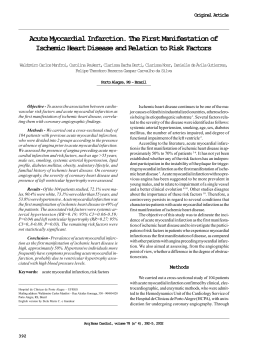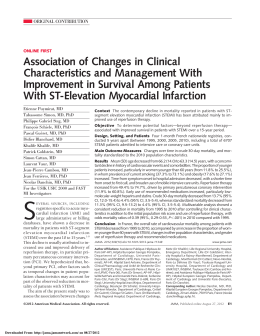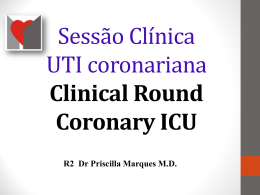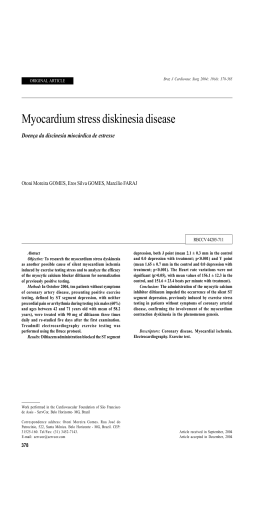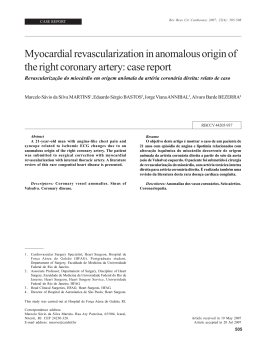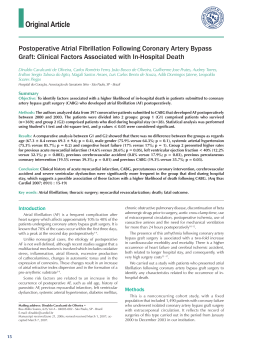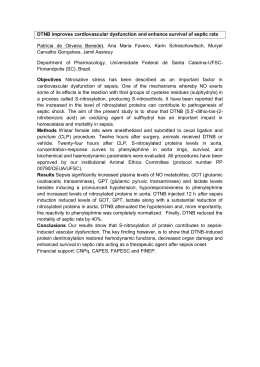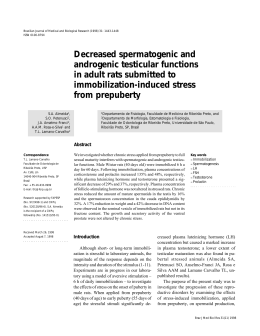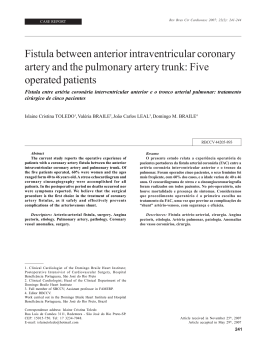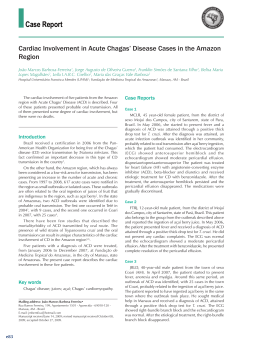Original Article Experimental Myocardium Infarction in Rats: Analysis of the Model Leonardo A. M. Zornoff, Sergio A. R. Paiva, Marcos F. Minicucci, Joel Spadaro Faculdade de Medicina de Botucatu, Botucatu, SP - Brazil Summary Method development One of the most often used strategies to study the physiopathological alterations caused by coronary occlusion is the use of the experimental infarction model in rats. Among other factors, this is due to the similarities in the physiopathological alterations that occur after the infarction in humans. One must consider, however, that this model has characteristics that can hinder the use as well as the interpretation of eventual outcomes. Thus, this review aims at analyzing the main characteristics of the experimental infarction model in rats, discussing the coronary occlusion technique, the consequences and the methods of morphological and functional assessment of the infarction and its clinical implications. The experimental AMI model in rats due to left coronary occlusion was initially described by Heimburger in 19463. With the passing time, the technique was progressively modified by Johns and Olson4, Kaufman et al5 and Seyle et al6. In the beginning of the 1980s, the method was introduced in Brazil at the School of Medicine of Botucatu7, and from there it spread to other Services. In short, after the anesthesia, a left thoracotomy is performed, between the 4th and the 5th intercostal spaces. The heart is exteriorized through lateral compression of the chest and the left coronary artery is ligated with 5-0-size suture thread at approximately 2 mm from its origin, between the left atrium border and the pulmonary artery sulcus (Figure 1). Then, the heart is rapidly returned to the thoracic cavity, the lungs are expanded with positive ventilation with 100% oxygen and the surgical wound is closed 3-6 . The method described above has several advantages. First, the animals can be raised specifically for the protocols, at a lower cost than with larger animals. Second, the surgery is extremely fast, with a duration ranging from 2 to 5 minutes. Another aspect is that due to the rat metabolism characteristics, the phases involved in the infarction evolution such as necrosis, healing and remodeling occur rapidly, which decreases the time of study observation. Finally, the morphological and functional alterations caused by the infarction are similar to those found in humans8,9. Introduction The acute myocardial infarction (AMI) is defined as a focus of necrosis that results from low tissue perfusion, with signs and symptoms that are the consequence of the cardiac cell death. It is estimated that this syndrome can occur in epidemic proportions worldwide. Few pathologies had their evolution altered so radically as the AMI, with an accentuated decrease in mortality due to the changes regarding its treatment in the last 30 years1,2. The change in the treatment was the result of advances obtained in the study of the pathogenesis of the AMI and its complications. This fact emphasizes the importance of a better understanding of the physiopathological mechanisms of the acute coronary syndromes. One of the most often used models to study the physiopathological alterations caused by coronary occlusion is the experimental infarction model in rats. However, the model presents several particular characteristics that can make it difficult to handle. Thus, the objective of this review is to discuss the main methodological aspects related to the experimental infarction model in the rats. Animals and surgery The most often used rat strains are Wistar and SpragueDawley, depending on the Service and animals weighing 200 to 250g are usually used in the studies. In this weight range, a rat is considered a young adult, when its evolution phase is characterized by slow growth and presents lower surgical mortality than older animals. It is also recommended to use animals of the same sex, as this variable can be an important regulation factor of the cardiac adaptations in response to several stimuli10,11. Myocardial infarction; animals, laboratory; rats; coronary occlusion. Regarding the anesthesia, several agents have been used, and among them, inhalation agents such as ether and isoflurane, as these drugs are relatively inexpensive plus the advantage of having a short-term action, in addition to allowing the variation of anesthesia intensity during surgery10. Mailling address: Leonardo Antônio Mamede Zornoff • Faculdade de Medicina de Botucatu, Departamento de Clínica Médica, Rubião Jr, 18.618-000, Botucatu, SP - Brasil E-mail: [email protected], [email protected] Manuscript received April 18, 2008; revised manuscript received May 29, 2008; accepted May 29, 2008. Barbiturates or the association of ketamine chloride (50 mg/kg) and xylidine chloride (1mg/kg) are also frequently used via intraperitoneal or intramuscular routes. These agents are fast-acting and can produce anesthesia within 5 minutes. It is important to remember that the agents with short half-life are preferable to the long-action ones10. Key Words 403 Zornoff et al Experimental infarction in rats Original Article Aspects related to the size of the infarction Figure 1 - Experimental infarction. Exteriorization of the heart for coronary suture at 2 mm from the origin, between the border of the left atrium and the pulmonary artery sulcus. During the procedure, it is recommended that the animals be artificially ventilated, with oxygen supplementation. Therefore, the animals can be ventilated by nasal compression, with catheter, or be submitted to mechanical ventilation after orotracheal intubation with a number 16 catheter10. After the surgery, the most commonly used analgesic drugs are morphine, dipyrone or paracetamol. Another aspect is that the environmental conditions must be kept constant, as temperature variations, for instance, can increase the mortality after the infarction. Mortality The observed mortality within the first 24 hrs after surgery is usually 40 to 60%. Among the causes of death in this period are mainly the factors related to the surgical procedure, such as pneumothorax and respiratory depression as well as factors associated to the cardiac pump failure, such as acute pulmonary edema10,12. The main cause of death in this model is, however, the high prevalence of malignant arrhythmias, such as sustained ventricular tachycardia and ventricular fibrillation. Opitz and cols. found a mortality of 65% in the first 48 hours after the infarction. Through continuous monitoring, the authors demonstrated that 96% of the animals submitted to the AMI presented hundreds of episodes of ventricular tachycardia and at least 20 episodes of ventricular fibrillation. Additionally, two distinct periods of arrhythmia were demonstrated: the first period included the first 30 minutes after the coronary occlusion and the second, responsible for 65% of the deaths, included the period between 1.5 and 9 hours after the infarction13. Regarding the chronic period after the AMI, the mortality observed in this model is extremely variable, with the size of the infarction being the main determinant of this event. In this sense, Pfeffer et al14, following infarcted animals for a period of one year, verified that for small (5 to 19.9% of the left ventricle), moderate (20 to 39.9%) and large infarctions (≥ 40%), the mortality rates were around 50%, 75% and 85%, respectively14. 404 Arq Bras Cardiol 2009; 93(3) : 403-408 One of the most relevant aspects of this model is related to the size of the infarction. It is accepted that this parameter resulting from the coronary occlusion, in its proximal region, is not uniform, varying from 4% to 65%12. This fact is a consequence of the incapacity of occluding the coronary exactly at the same point in all animals, as well as of eventual anatomic variations among them. Thus, this model is not adequate for the verification of the reduction effect of infarct size through different interventions, as eventual differences in the infarction size might be inherent to the variability of the method. Consequently, it is recommended first the analysis of the risk area affected by the coronary artery ligation in a certain point, through the injection of dyes. Subsequently, starting from the risk area, the size of the final infarcted area is verified15,16. Another factor to be considered is the site of the occlusion of the coronary artery. When the occlusion occurs too close to the origin, there is the septal artery involvement and the size of the infarction can be higher than 65%. In this case, however, the mortality of the animals is 100%12,14. Another relevant characteristic is that, in this experimental model of AMI, the percentage of infarction at the apex is higher than that at the basis of the left ventricle. For this reason, the most often used method to determine the size of the infarction is the one that uses several transversal cuts. The size of the infarction is determined by the mean of all cuts. Different authors, however, have observed that the medial transversal cut of the left ventricle, between 5 and 6 mm from the apex, reflects the size of the infarction of the entire left ventricle17,18. Therefore, the use of this region alone would simplify the measurement of the infarction size. Regarding the methods used to determine the infarction size, this variable has been assessed, preferentially, by 4 different methods: 1) measurement of the infarcted area in relation to the left ventricle area, determined by histology or planimetry; 2) histology with the measurement of the internal perimeter of the infarcted area in relation to the total perimeter of the cavity; 3) histology with the measurement of epicardial and endocardial circumferences of the infarcted and non-infarcted segments and 4) echocardiogram with the measurement of the internal perimeter of the infarcted region in relation to the total perimeter of the cavity. The most often recommended method for determining the infarction size is the measurement of the epicardial and endocardial circumferences of the infarcted and noninfarcted segments (Figure 2)12,14,19. A potential limitation to the use of different techniques is, as mentioned before, the fact that the size of the infarction can vary, depending on the method used. Regarding the measurement of the infarction size by the area, one must consider that, after the infarction, dynamic alterations occur in the infarcted segment as well as in the non-infarcted area. In the infarcted region, the necrotic tissue is substituted by fibrous scar tissue. At the later phases of the healing process, the contraction of the fibrotic area occurs8. On the other hand, in the non-infarcted area of the left ventricle, different degrees of cardiac hypertrophy occur, Zornoff et al Experimental infarction in rats Original Article such as adaptation to the loss of the myocytes. Due to these alterations, the measurement of the infarction size by volume or area can result in error, as the resorption and retraction of the infarcted area, added to the hypertrophy of the noninfarcted region, can result in the underestimation of the infarction size in relation to the original infarcted area12,14,20. Another method used to determine the size of the infarction is the measurement of the internal perimeter of the infarcted segment, in relation to the total perimeter of the ventricular cavity. This analysis can be attained by two methods: echocardiogram and histology. However, similarly to the estimate made by area, these methods can present important limitations. Simultaneously to the necrosis of the myofibrils, there is interfibrillar collagen disintegration by the activation of proteolytic enzymes. This fact causes loss of the support tissue, which makes the region more distensible and, consequently, more susceptible to deformations. Thus, the slippage of muscular necrotic areas can occur, with the realignment of the myocytes on the infarcted wall. As a result, there is a narrowing of the region and dilation of the infarcted segment. This acute dilation, characterized by the thinning and distension of the infarcted region is called the infarction expansion21-23. Therefore, as a consequence of the expansion, the measurement of the infarction size by the internal perimeters can overestimate the size of the AMI20. Morphological characteristics Regarding the anatomic characteristics of the rat’s heart, the left coronary artery originates between the border of the left atrium and the pulmonary artery sulcus. Additionally, it was observed that the left coronary artery, in its proximal region, is usually intramyocardial, returning to the surface epicardially at approximately 3 to 4 mm from its origin4. The rat does not have a true circumflex artery6. The proximal region of the left coronary artery, practically at the ostium, gives origin to the septal branch and, farther down, to the branch that corresponds to the circumflex artery17. This anatomic characteristic ensures that the septal branch originates above the site where the coronary occlusion is performed. Thus, this model is characterized by presenting infarction of the left ventricular free wall, without involving the interventricular septum. Consequently, this region is used as control for morphological and biochemical studies17. Another anatomic characteristic of this model is that the rat has scarce collateral circulation, similarly to humans. The coronary occlusion invariably causes, therefore, transmural infarctions, making the subendocardial infarction a rare event, of around 3%24. Another pertinent aspect of this model is related to the involvement of the papillary muscle. Contrary to the dog model, in which the coronary occlusion leads to necrosis of the papillary muscle in 85% of the cases, the infarction model in rats is characterized by the preservation of posterior papillary muscle. The histological analysis showed that, in rats, the coronary occlusion does not affect or minimally affects this muscle. The explanation for this phenomenon is that the irrigation of the posterior papillary muscle is carried out by the septal branch of the left coronary artery, which, as discussed above, is not affected by the coronary occlusion17. Figure 2 - Evaluation of the infarction size through the measurement of the epicardial and endocardial circumferences of the infarcted segments (right) in relation to the total epicardial and endocardial circumferences of the left ventricle (left). Regarding the healing characteristics after the coronary occlusion, the rat model also shows some peculiarities25-31. The activation of metalloproteases (MMP), proteolytic enzymes responsible for collagen degradation, was identified 1 hour after the coronary occlusion28. Initially, the MMP degrades the fibrillar collagen and, subsequently, the MMP-2, MMP3 and MMP-9 degrade these fragments26. A previous study suggests that, 3 hours after the coronary occlusion, around 50% of the collagen has been degraded28. This proteolytic activity ceases one week after the infarction27. Concomitant to the proteolytic activity, other alterations have been identified. After 24 hours, the muscular necrosis becomes evident, initially followed by a neutrophilic infiltration and later, by a lymphocytic and monocytic infiltrate30. Three to four days after the coronary occlusion, the accumulation of fibroblast-like cells start, but with actin in its composition, the myofibroblasts. It is accepted that the myofibroblasts are fibroblasts modified by the TGF-β secreted by the monocytes and responsible for the synthesis of collagen I and III, which starts to accumulate in the peripheral region of the infarction on the third day and becomes well organized 14 days after the AMI. The healing process is complete 21 days after the coronary occlusion25-31. Another aspect that must be considered is that, in animals with large infarctions, the non-infarcted areas of the left ventricle and the of the right ventricle show an increase in the expression of pre-collagen types I and III mRNA, starting between 4 to 7 days after the AMI, which can result in the accumulation of progressive collagen. Therefore, large infarctions are often accompanied by different degrees of fibrosis in the non-infarcted areas26. One of the main characteristic of myocardial infarction is associated to the fact that the loss of contractile tissue triggers an adaptive cell growth process in the non-infarcted tissue32-37. In the rat model, the left ventricular hypertrophy is characterized for having an eccentric pattern, being an early event and being detectable on the third day after the coronary occlusion. After three to four weeks, the degree of hypertrophy increases between 30% and 60%. Hypertrophy can also occur in the right ventricle, characteristically with a concentric pattern and correlated to increases in the left-ventricular end-diastolic pressure and right ventricular Arq Bras Cardiol 2009; 93(3) : 403-408 405 Zornoff et al Experimental infarction in rats Original Article systolic pressure12. However, similarly to what occurs in the infarcted ventricle, the right ventricular hypertrophy is present on the third day and affects around 30% at the end of one month38,39. Finally, similarly to what occurs in the infarcted area, the non-infarcted area, mainly the one that separates the infarcted tissue from the non-affected tissue, can also be the target of MMP activation. As a consequence, bundles of viable myocytes can undergo muscular slippage and realignment processes (side-to-side slippage)40. Thus, as a consequence of the processes of expansion, of ventricular hypertrophy (of eccentric characteristic) and of cell slippage in the region that is borderline with the infarction area, the infarcted cavity can increase in diameter and lose its normal elliptical geometry, taking on a spherical configuration. These changes in size, mass and ventricular geometry clinically characterize the process of cardiac remodeling after the infarction41-47. Functional characteristics The hemodynamic consequences caused by the coronary occlusion in the rat have been well documented. Different studies have shown that the infarction causes the decrease of several functional variables, such as systolic volume, cardiac output, left ventricular systolic pressure, first positive pressure derivative and negative pressure derivative. In parallel, there is an increase in the left ventricular-end diastolic pressure and of the decline time constant of the isovolumetric pressure. The infarction is accompanied, therefore, by systolic as well as diastolic dysfunctions, which are identified as early as 3 hours after the coronary occlusion12,48-51. Regarding the mechanisms involved in the ventricular dysfunction, there is evidence that up to the three first weeks after large infarctions, the non-infarcted muscle function is normal, although the chamber function is depressed37. On the other hand, after 6 weeks, the muscular function is depressed52. Thus, this evidence suggests that, initially, the ventricular dysfunction is a consequence of the loss of contractile tissue, secondary to the infarction. Chronically, however, the remaining muscle becomes dysfunctional, probably due to the post-infarction remodeling process. One of the main characteristics of this model is that the functional alterations are closely related to the size of the infarction. Therefore, rats with infarctions < 30% did not present hemodynamic abnormalities. Animals with moderate infarctions (31-46%) had normal basal hemodynamic values, but reduced pressure-generating capacity. On the other hand, rats with large infarctions (> 46%) presented heart failure, with elevated filling pressures and cardiac output decrease12. Therefore, this model allows the study of different degrees of ventricular dysfunction. Finally, the experimental infarction model in rats allows the evaluation of the right ventricular function. Thus, in a previous study, in which an isolated heart preparation was used, perfused with a nutrient solution, a decrease in the systolic pressure was identified, which correlated, in linear form, with the increase in the right ventricular mass53. 406 Arq Bras Cardiol 2009; 93(3) : 403-408 Morphological, functional and clinical evaluation of heart failure To evaluate hypertrophy in different models of cardiac injury, the ratio between the left ventricular weight, adjusted by the body weight of the animal of by the tibia, is commonly used. In the infarction model, however, the complex interaction of events such as the resorption of the necrotic tissue and the amount of collagen of the scar can interfere with the weight of the infarcted ventricle so that it won’t reflect the actual cell growth. Therefore, the use of the myocyte transversal diameter is preferable for the evaluation of the degree of left ventricular hypertrophy in this model54. On the other hand, to determine the right ventricular hypertrophy, ratios with body weight can be used55. To evaluate the amount of collagen of the non-infarcted tissue, the most commonly used methods are: hydroxyproline measurement56, interstitial collagen fraction57 and detection of collagens I and III26 through the RNA analysis or anti-collagen I and III antibodies. An important fact is that, although it is an indirect method, a close correlation between the biochemical method and the amount of collagen analyzed by morphometry was verified58,59. For the functional assessment, several methods are available: analysis by the papillary muscle 60, isolated heart61,62 and invasive hemodynamic evaluation12,63. In the recent years, however, the echocardiogram has become increasingly important in the morphological and functional assessment of infarcted rats. There are several functional variables that can be used, but the most frequent ones are: variation in area fraction, shortening fraction, cardiac output, segmental wall motion score, transmitral flow and cardiac performance index51,64-67. There are several clinical variables that can be used for the diagnosis of heart failure in this model, among which are: general appearance, slow movements, alterations in fur texture, delayed growth, body weight and dyspnea. These variables, however, can be little sensitive for the diagnosis of congestion or low cardiac output12. The first studies for the clinical detection of heart failure signs in rats were carried out by Bing and cols. that studied spontaneously hypertensive rats with heart dysfunction 68-70. The data on the incidence of post-infarction heart failure and the possibility of its clinical recognition in rats, however, are scarce. Recently, using the rat model with moderate and large infarctions, the observed prevalence of clinical and anatomopathological signs of heart failure was tachypnea, (46%); liver congestion, (21%); thrombus in the left atrium, (21%); ascites, (25%); pleural-pericardial effusion, (71%) and right ventricular hypertrophy, (100%)71. Implications The first implication of this model is related to the fact that, as it frequently results in large transmural infarctions located in the anterior wall, the infarction model in rats is ideal for the study of the physiopathology of post-infarction remodeling, Zornoff et al Experimental infarction in rats Original Article as these variables are the great determinants of the presence and intensity of the remodeling process41-47. Another implication is the similarity with the physiopathological alterations that occur after infarctions in humans52. For this reason, this model is ideal for the study of therapeutic interventions to minimize the morphological and functional alterations that can occur after the infarction. Thus, many of the interventions used in infarction patients were initially analyzed in the rat model, such as: angiotensinconverting enzyme inhibitors14,41, angiotensin-II receptor antagonists72, aldosterone antagonists73 and betablockers74. As demonstrated, the experimental infarction model in rats has been widely used for the study of the outcomes that occur after the coronary occlusion. Due to the animal’s inherent characteristics, we believe that the discussion of the main aspects of this model is extremely useful for those dedicated to the study of the acute myocardial infarction. Potential Conflict of Interest No potential conflict of interest relevant to this article was reported. Sources of Funding There were no external funding sources for this study. Study Association This study is not associated with any post-graduation program. References 1. Braunwald E. Evolution of the management of acute myocardial infarction: a 20th century saga. Lancet. 1998; 352: 1771-4. 2. Antman EM, Hand M, Armstrong PW, Bates ER, Creen LA, Halasyamani LK, et al. 2007 focused update of the ACC/AHA 2004 guidelines for the management of patients with ST-elevation myocardial infarction. Circulation. 2008; 117: 296-329. al. High-dose folic acid pretreatment blunts cardiac dysfunction during ischemia coupled to maintenance of high-energy phosphates and reduces postreperfusion injury. Circulation. 2008; 117: 1810-9. 17.Spadaro J, Fishbein MC, Hare C, Pfeffer MA, Maroko PR. Characterization of myocardial infarcts in the rat. Arch Pathol Lab Med. 1980; 104: 179-83. 3. Heimburger RF. Injection into pericardial sac and ligation of coronary artery of the rat. Arch Surg. 1946; 52: 677-89. 18.Oh B-H, Ono S, Rockman HR, Ross J Jr. Myocardial hypertrophy in the ischemic zone induced by exercise in rats after coronary reperfusion. Circulation. 1993; 87: 598-607. 4. Johns TNP, Olson BJ. Experimental myocardial infarction: I. Method of coronary occlusion in small animals. Ann Surg. 1954; 140: 675-82. 19.Maclean D, Fishbein MC, Maroko PR, Braunwals E. Hyaluronidase-induced reduction in myocardial infarction size. Science. ����������������������������� 1976; 194: 199-200. 5. Kaufman N, Gavan TL, Hill RW. Experimental myocardial infarction in the rat. Arch Pathol Lab Med. 1959; 67: 482-8. 20.Minicucci MF, Azevedo OS, Duarte DR, Matsubara BB, Matsubara AO, Campana AO, et al. Comparison �������������������������������������������������������� of different methods to measure experimental chronic infarction size in the rat model. Arq Bras Cardiol. 2007; 89: 83-7. 6. Selye H, Bajusz E, Grassos S, Mendell P. Simple techniques for the surgery occlusion of coronary vessels in the rat. Angiology. 1960; 11: 398-407. 7. Spadaro J, Hashimoto LM, Franco RSS, Bregagnollo EA, Tucci PJF. ����������� Efeitos da administração prévia de amiodarona na incidência precoce de fibrilação ventricular durante isquemia miocárdica experimental. ������������������ Arq Bras Cardiol. 1984; 42: 25-9. 8. Fishbein MC, Maclean D, Maroko PR. Experimental myocardial infarction in the rat. Am J Pathol. 1978; 90: 57-70. 9. Klocke R, Tian W, Kuhlmann MT, Nikol S. Surgical animal models of heart failure related to coronary heart disease. Cardiovasc Res. 2007; 74: 29-38. 10.Litwin SE. The rat model of postinfarction heart failure. Heart Fail. 1995; 11: 182-95. 11.Jain M, Liao R, Podesser BK, Ngoy S, Apstein CS, Eberli FR. Influence of gender on the response to hemodynamic overload after myocardial infarction. Am J Physiol Heart Circ Physiol. 2002; 283: H2544-50. 12.Pfeffer MA, Pfeffer JM, Fishbein MC, Fletcher PJ, Spadaro J, Kloner RA, et al. Myocardial infarct size and ventricular function in rats. Circ Res. 1979; 44:503-12. 13.Opitz CF, Mitchell GF, Pfeffer MA, Pfeffer JM. Arrhythmias and death after coronary artery occlusion in the rat: continuous telemetric ECG monitoring in conscious, untethered rats. Circulation. 1995; 92: 253-61. 14.Pfeffer MA, Pfeffer JM, Steimberg BS, Finn P. Survival after an experimental myocardial infarction: beneficial effects of long-term therapy with captopril. Circulation. 1985; 72: 406-12. 15.Li Y, Kloner RA. Is there a gender difference in infarct size and arrhythmias following experimental coronary occlusion and reperfusion? J Thromb Thrombolysis. 1995; 2: 221-5. 16.Moens AL, Champion HC, Claeys MJ, Tavazzi B, Kaminski P, Wolin M, et 21.Hockman JS, Bulkley BH. Expansion of acute myocardial infarction: an experimental study. ������������������������������� Circulation. 1982; 65: 1446-50. 22.Matsubara BB, Zornoff LAM. Matriz colágena intersticial e sua relação com a expansão miocárdica no infarto agudo. Arq ����������������������������������� Bras Cardiol. 1995; 64: 559-63. 23.Hutchins GM, Bulkley BH. Infarction expansion versus extension: two different complications of acute myocardial infarction. Am J Cardiol. 1978: 73: 843-9. 24.Cooper CJ, Pfeffer JM, Finn PV, Pfeffer MA. Characteristics of a model of myocardial infarction produced by coronary artery ligation in the rat. Cardiovasc Pathol. 1995; 4: 189-94. 25.Ertl G, Frantz S. Healing after myocardial infarction. Cardiovasc Res. 2005; 66: 22-32. 26.Sun Y, Weber KT. Infarct scar: a dynamic process. Cardiovasc Res. 2000; 46: 250-6. 27.Sun Y, Kiani MF, Postlethwaite AE, Weber KT. Infarct scar as living tissue. Bas Res Cardiol. 2002; 97: 343-7. 28.Holmes JW, Borg TK, Cowel JW. Structure and mechanics of healing myocardial infarction. Ann Rev Biomed Eng. 2005; 7: 223-53. 29.Whittaker P. Unravelling the mysteries of collegen and cicatriz after myocardial infarction. Cardiovasc Res. 1995; 29: 758-62. 30.Fishbein MC, Maclean D, Maroko PR. The histopathologic evolution of myocardial infarction. Chest. 1978; 73: 843-9. 31.Jugdutt BI. Ventricular remodeling after infarction and the extracellular collagen matrix: when is enough enough? Circulation. 2003; 108: 1395-403. 32.Olivetti G, Capasso JM, Meggs LG, Sonnenblic EH, Anversa P. Cellular basis of chronic ventricular remodeling after myocardial infarction in rats. Circ Res. Arq Bras Cardiol 2009; 93(3) : 403-408 407 Zornoff et al Experimental infarction in rats Original Article 1991; 68: 856-69. 33.Rubin SA, Fishbein MC, Swan HJC. Compensatory hypertrophy in the heart after myocardial infarction in the rat. J Am Coll Cardiol. 1983; 6: 1435-41. 34.Capasso JM, Li Peng, Zhang X, Anversa P. Heterogeneity of ventricular remodeling after acute myocardial infarction in rats. Am J Physiol. 1992; 262: H486-95. 35.Anversa P, Loud AV, Levicky V, Guideri G. Left ventricular failure induced by myocardial infarction. I. Myocyte hypertrophy. Am J Physiol. 1985; 248: H876-82. 56.Mill JG, Milanez MC, Busatto VC, Moraes AC, Gomes MG. Ativação ������������ da enzima conversora da angiotensina no coração após infarto do miocárdio e suas repercussões no remodelamento ventricular. Arq Bras Cardiol. 1997; 69: 101-10. 57.Zornoff LAM, Duarte DR, Minicucci MF, Azevedo PS, Matsubara BB, Matsubara LS, et al. ��������������������������������������������������������� Effects of beta-carotene and smoking on heart remodeling after myocardial infarction. Arq Bras Cardiol. 2007; 89: 135-41. 36.Anversa P, Olivetti G, Capasso JM. Cellular basis of ventricular remodeling after myocardial infarction. Am J Cardiol. 1991; 68: D7-16. 58.Nicoletti A, Heudes D, Hinglais N, Appay MD, Philippe M, Sassy-Prigent C, et al. Left ventricular fibrosis in renovascular hypertensive rats: effect of losartan and spironolactone. Hypertension. 1995; 26: 101-11. 37.Bing OH, Brooks WW, Conrad CH, Weinstein KB, Spadaro J, Radvany P. Myocardial mechanics of infarcted and hypertrophied non-infarcted myocardium following experimental coronary artery occlusion. International Erwin Riesch Symposium. Tuebingen, Germany. Stein-Kopf Darmstadt, 1983. p. 235-44. 59.Weber KT, Janicki JS, Shroff SG, Pick R, Chen RM, Bashey RI. Collagen remodeling of the pressure-overload, hypertrophied nonhuman primate myocardium. Circ Res. 1988; 62: 757-65. 38.Spadaro J, Cicogna AC, Tucci PJF, Cury PR, Montenegro MR. Morphometric evaluation of the time course of right ventricular hypertrophy after left coronary artery ligation in rats. Braz J Med Biol Res. 1989; 22: 517-22. 39.Anversa P, Sonnenblic EH. Isquemic cardiomyopathy: pathophysiologic mechanisms. Prog Cardiovasc Dis. 1990; 33: 49-70. 40.Olivetti G, Capasso JM, Sonnenblic EH, Anversa P. Side-to-side slippage of myocites participates in ventricular wall remodeling acutely after myocardial infarction in rats. Circ Res. 1990; 67: 23-34. 41.Pfeffer JM, Pfeffer MA, Braunwald E. Influence of chronic captopril therapy on the infarcted left ventricle of the rat. Circ Res. 1985; 57: 84-95. 42.Pfeffer MA, Braunwald E. Ventricular remodeling after myocardial infarction: experimental observations and clinical implications. Circulation. 1990; 81:1161-72. 43.Cohn JN, Ferrari R, Sharpe N. Cardiac remodeling-concepts and clinical implications: a consensus paper from an international forum on cardiac remodeling. ������������������������������������ J Am Coll Cardiol. 2000; 35: 569-82. 44.Zornoff LAM, Spadaro J. Remodelação ventricular após infarto agudo do miocárdio: conceitos, fisiopatologia e abordagem terapêutica. ��������� Arq Bras Cardiol. 1997; 68: 453-60. 45.Swynghedauw B. Molecular mechanisms of myocardial remodeling. Physiol Rev. 1999; 79: 215-62. 46.Udelson JE, Patten RD, Konstam MA. New concepts in post-infarction ventricular remodeling. Rev Cardiovasc Med. 2003; 4 (Suppl 3): S3-12. 60.Mill JG, Zornoff LAM, Okoshi MP, Okoshi K, Padovani CR, Sugizaki MM, et al. The early administration of growth hormone results in deleterious effects on ventricular remodeling after acute myocardial infarction. Arq Bras Cardiol. 2005; 84: 115-21. 61.Zornoff LA, Paiva SA, Matsubara BB, Matsubara LS, Spadaro J. Combination therapy with angiotensin converting enzyme inhibition and AT1 receptor inhibitor on ventricular remodeling after myocardial infarction in rats. ��J Cardiovasc Pharmacol Ther. 2000; 5: 203-9. 62.Paiva SAR, Matsubara LS, Matsubara BB, Minicucci MF, Azevedo PS, Campana AO. ���������������������������������������������������������������������� Retinoic acid supplementation attenuates ventricular remodeling after myocardial infarction in rats. J Nutr. 2005; 135: 2326-8. 63.deFelice A, Frering R, Horan P. Time course of hemodynamic changes in rats with healed severe myocardial infarction. Am J Physiol. 1989; 257: H289-96. 64.Solomon SD, Greaves SC, Ryan M, Finn P, Pfeffer MA, Pfeffer JM. Temporal dissociation of left ventricular function and remodeling following experimental myocardial infarction in rats. J Card Fail. 1999; 5: 213-23. 65.Morgan EE, Faulx MD, McElfresh TA, Kung TA, Zawaneh MS, Stanley WC, et al. Validation of echocardiographic methods for assessing left ventricular dysfunction in rats with myocardial infarction. Am J Physiol Heart Circ Physiol. 2004; 287: H2049-53. 66.Staastad I, Sejersted OM, Ilebekk A, Bjornerheim R. Echocardiographic criteria for detecting of postinfarction congestive heart failure in rats. J Appl Physiol. 2000; 89: 1445-54. 47.Tiyyagura SR, Pinney S. Left ventricular remodeling after myocardial infarction: past, present, and future. Mt Sinai J Med. 2006; 73: 840-51. 67.Saraiva RM, Kanashiro-Takeuchi RM, Antonio EL, Campos O, Tucci PJ, Moisés VA. Rats with high left ventricular end-diastolic pressure can be identified by Doppler echocardiography one week after myocardial infarction. Braz J Med Biol Res. 2007; 40: 1557-65 48.Fletcher PJ, Pfeffer JA, Pfeffer MA, Braunwald E. Left ventricular diastolic pressure-volume relations in rats with healed myocardial infarction: effects on systolic function. Circ Res. 1981; 49: 618-26. 68.Bing OHL, Brooks WW, Robinson KG, Slawsky MT, Hayes JA, Litwin SE, et al. The spontaneously hypertensive rat as a model of the transition from compensated left ventricular hypertrophy to failure. J Mol Cell Cardiol. 1995; 27: 383-96. 49.Raya TE, Gay RG, Lancaster L, Aguirre M, Moffett C, Goldman S. Serial changes in left ventricular relaxation and chamber stiffness after large myocardial infarction in rats. Circulation. 1988; 77: 1424-31. 69.Conrad CH, Brooks WW, Hayes JA, Sen S, Robinson KG, Bing OHL. Myocardial fibrosis and stiffness with hypertrophy and heart failure in the spontaneously hypertensive rat. Circulation. 1995; 91: 161-70. 50.Litwin SE, Raya TE, Anderson PG, Litwin CM, Bressler R, Goldman S. Induction of myocardial hypertrophy after coronary ligation in rats decreases ventricular dilation and improves systolic function. Circulation. 1991; 84: 1819-27. 70.Brooks WW, Bing OHL, Robinson KG, Slawsky MT, Chaletsky DM, Conrad CH. Effect of angiotensin-converting enzyme inhibition on myocardial fibrosis and function in hypertrophied and failing myocardium from the spontaneously hypertensive rat. Circulation. ������������������������������� 1997; 96: 4002-10. 51.Litwin SE, Katz SE, Morgan JP, Douglas PS. Serial echocardiographic assessment of left ventricular geometry and function after large myocardial infarction in the rat. Circulation. 1994; 89: 345-54. 71.Martinez PF, Zornoff LAM, Campos DHS, Oliveira Jr AS, Damato RL, Gosuen G, et al. Caracterização clínica e anátomo-patológica da insuficiência cardíaca induzida por infarto do miocárdio em ratos. Arq ������������������������ Bras Cardiol. 2007; 88 (supl): 14. 52.Goldman S, Raya TE. Rat infarct model of myocardial infarction and heart failure. J Card Fail. 1995; 1: 169-77. 53.Stefanon I, Martins MA, Vassallo DV, Mill JG. Analysis of right and left ventricular performance of the rat heart with chronic myocardial infarction. Braz J Med Biol Res. 1994; 27: 2667-79. 54.Zornoff LAM, Matsubara BB, Matsubara LS, Minicucci MF, Azevedo PS, Campana AO, et al. Cigarette smoke exposure intensifies ventricular remodeling process following myocardial infarction. Arq Bras Cardiol. 2006; 86: 276-82. 55.Zornoff LAM, Matsubara BB, Matsubara LS, Paiva SAR, Spadaro J. Early rather 408 than delayed administration of lisinopril protects the heart after myocardial infarction in rats. Basic Res Cardiol. 2000; 95: 208-14. Arq Bras Cardiol 2009; 93(3) : 403-408 72.Zornoff LAM, Matsubara LS, Matsubara BB, Paiva SAR, Spadaro J. Effects of losartan on ventricular remodeling in experimental infarction in rats. Arq ��������� Bras Cardiol. 2000; 75: 459-70. 73.Mill JG, Milanez MC, Resende MM, Gomes MG, Leite CM. Spironolactone ��������������� prevents cardiac collagen proliferation after myocardial infarction in rats. Clin Exp Pharmacol Physiol. 2003; 30: 739-44. 74.Fishbein MC, Li-Quan L, Rubin S. Long-term propranolol administration alters myocyte and ventricular geometry in rat hearts with and without infarction. Circulation. 1988; 78: 369-75.
Download
